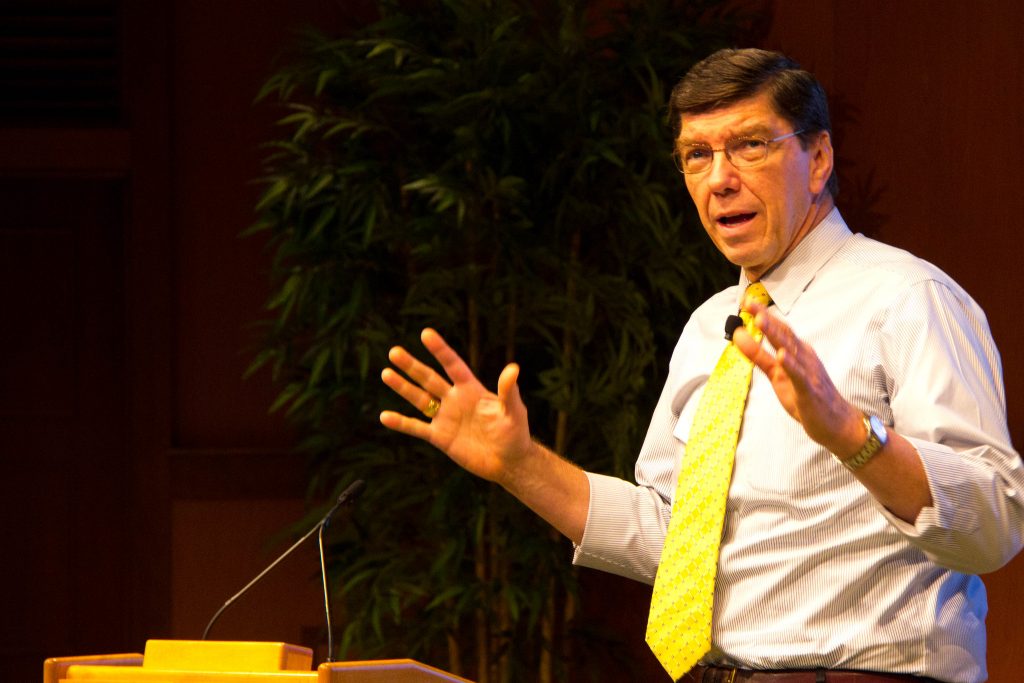
Education has lost one its most important disruptors: Clayton Christensen, PhD and distinguished professor at Harvard Business School. After a successful career as the CEO of CPS Technologies, Christensen returned to school at age 40 to earn his PhD in business from Harvard University. He became a well-known scholar, particularly for his key contributions to our understanding of innovation and disruption. Christensen died on January 23.
Possibly one of his most important predictions of disruption playing out in the marketplace is about his own industry: higher education. After accepting an offer from the University of Phoenix to teach online lectures on various business principles, Christensen began to see the tide turning in favor of online higher education. Entertainment and cost-effectiveness were the main aspects of his University of Phoenix online lectures and he saw them becoming the order of the day in online higher education.
Online higher education solves many issues that traditional colleges and universities cannot even seem to approach: A large number of low-quality professors and a short supply of high-quality professors; exorbitant costs for housing and boarding on university campuses; and the massive capital cost for underutilized buildings.
Online higher education allows for one high-quality professor to teach thousands, or even millions, of viewers. Over time, even high-quality professors will be disrupted, as Christensen points out in his 2011 book, The Innovative University:
Teaching performance in the online environment is easily monitored, and course-by-course contracting creates a Darwinian incentive to improve. [Another] source of improvement is the oversight role played by professional course designers. These specialists not only have training and experience in enhancing learning outcomes, they have that goal as their sole objective, without the mixed motives of the full-time professor who favors a particular teaching style or subject matter emphasis.
The quality of education will soar relative to the dip in the cost of education as teachers become better and better at disseminating knowledge to students in an online format.
For online students, university housing and boarding costs become obsolete, as well as the funding of new buildings. That is a cost that Christensen consistently pointed to in his commentary on the current issues with the university system in the United States: “The American-style university is by design hungry for expensive brick-and-mortar investment and relatively inefficient in its use. That is particularly true of intercollegiate athletic facilities, which sit mostly idle even when school is in session.” (That quotation again is from The Innovative University, as are the others in this article.) Online education results in cost savings for students due to many factors, but especially because of the lack of physical building upkeep.
It’s not only higher education that will be revolutionized by the internet, but education as a whole. Two major disruptors of online learning are Khan Academy and Prager U: Both institutions deliver the highest-quality videos in a short amount of time, for free. That is the future of education that Clayton Christensen foresaw and the future of education that will rock the world of traditional colleges and universities, as “their future success depends on reducing their instructional costs via online learning and providing the student support necessary to increase their graduation rates.”
Although online education still has many critics, Christensen saw its great potential for disrupting the staid, tradition-bound world of higher education. In fact, he predicted in 2011 that as many as half of the country’s colleges and universities would close or merge within the next decade. (He somewhat softened that prediction in 2018, as Michael Horn related here.)
Christensen redefined marketing by determining that “we hire products and services to do things for us.” Understanding why students hire colleges is critical to understanding the future of higher education. The disruption can only occur after understanding what we want this product to do, which makes it easier to determine how to improve the product. When we apply that logic to higher education, it is clear that most students want a well-paying job, and some have predetermined their vocational track.
The operations of college have not changed substantially during the last 500 years, as Christensen makes it clear that “the need for universities’ discoveries, memories, and mentoring is greater than ever, and their capacity to perform those functions is unique.” Buildings are more plentiful, and facilities are of much higher quality, but buildings and facilities don’t educate. The credentials of the professors have expanded, research has become a higher priority, and writing books and papers is a high priority. None of those inputs improve the education of the students—if we allow an exception for the most brilliant professors such as Christensen himself. Christensen points out that “teaching will be disruptable as online technology improves and shifts the competitive focus from a teacher’s credentials or an institution’s prestige to what students actually learn.”
Clayton Christensen was “cautiously optimistic” about higher education’s future, but explained that “[i]f traditional universities and colleges can change their DNA quickly enough to avoid serious disruption they will have defied a huge amount of experience and data.” He knew that universities and colleges resist change and that many are not up to the task of changing their DNA. Therefore, it will be up to the entrepreneurs and innovators to introduce new higher education solutions for all, following the principles that Christensen set forth.
Robert Luddy is the founder of CaptiveAire Systems, Inc. and Thales Academy, Franklin Academy, and St. Thomas More Academy, a network of schools with over 5,000 students.
